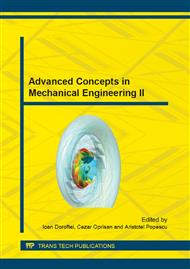p.515
p.521
p.527
p.533
p.539
p.545
p.553
p.559
p.565
Researches Regarding the Improvement of the Design for Vineyard Spraying Equipment
Abstract:
Pest and disease control in vineyards and orchards is a key feature for obtaining healthy and economically efficient crops, spraying equipments being widely used for plant protection. The technical performance of the spraying equipment has a significant effect over the efficiency indices of the plant protection methods: specific consumption of chemical solution, working capacity of the spraying units, fuel consumption, homogeneity of distribution over the entire foliage system etc. In this paper a new design of the vineyard spraying equipment was investigated, aiming for the partial recovery of the chemical solution, which otherwise would be lost; thus the consumption of chemical substance was decreased. The sprayer was equipped with recovery panels, mounted sideways, in order to retain the liquid droplets which would otherwise pass through the foliar system. The above-mentioned system can be mounted on different types of universal vineyard spraying machines. The laboratory tests confirmed that the consumption of liquid substance was significantly reduced, while the working parameters of the spraying equipment were not affected.
Info:
Periodical:
Pages:
539-544
Citation:
Online since:
October 2014
Authors:
Keywords:
Price:
Сopyright:
© 2014 Trans Tech Publications Ltd. All Rights Reserved
Share:
Citation:


